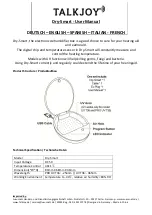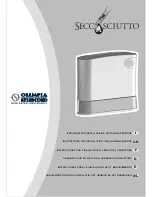
EN
15
dehumidifier TTK 165 ECO / TTK 170 ECO / TTK 380 ECO
Automatic defrost
At low ambient temperatures, ice may form at the evaporator
during dehumidification. The device will then carry out an
automatic defrost. Dehumidification is briefly interrupted during
defrosting. The fan keeps running.
In case of the device
TTK 165 ECO
defrosting takes place
electronically in air circulation mode. In defrost mode, the
compressor switches off while the fan keeps running and
circulates the compressor's waste heat around the evaporator
for defrosting.
The devices TTK 170 ECO and TTK 380 ECO come with a hot
gas automatic defrost system based on the bypass procedure.
Here, the hot gas of the refrigerant circuit is used actively for
fast and effective defrosting. As soon as ice starts to form, a
special valves opens automatically, redirects the hot gas to the
evaporator, and closes again after defrosting is completed so
that drying operation can be continued via the regular
refrigerant circuit. Unlike air circulation defrosting, hot gas
automatic defrosting allows for considerably shorter defrost
phases, which is an essential requirement for effective
dehumidification in low-temperature surroundings (below 15 °C)
such as unheated rooms. After all, the actual dehumidification
process only takes place when defrosting is not in progress.
The duration of the defrost process can vary. Do
not
switch off
the device during automatic defrost. Do
not
remove the mains
plug from the mains socket.
External hygrostat (optional)
The devices TTK 170 ECO and TTK 380 ECO allow for
connection of the external hygrostat HG 110. The desired
humidity can be regulated by use of a hygrostat. The external
hygrostat is connected to the connection for the external
hygrostat (13).
Shutdown
Warning of electrical voltage
Do not touch the mains plug with wet or damp hands.
•
Switch off the device.
•
Hold onto the mains plug while pulling the power cable out
of the mains socket.
•
If necessary, remove the condensation drain hose and any
residual fluid from it.
•
Empty the condensation tank, if need be.
•
Clean the device according to the Maintenance chapter.
•
Store the device according to the Transport and storage
chapter.
Available accessories
Warning
Only use accessories and additional equipment
specified in the instructions.
Using insertion tools or accessories other than those
specified in the instructions may cause a risk of injury.
TTK 170 ECO / TTK 380 ECO
Designation
Article number
Air filter TTK 165 ECO
7.710.000.115
Air filter TTK 170 ECO
7.710.000.006
Air filter TTK 380 ECO
7.710.000.851
External condensate pump
6.100.003.020
Hygrostat HG 110 with jack plug
(TTK 170 ECO and TTK 380 ECO)
6.100.002.044
Errors and faults
The device has been checked for proper functioning several
times during production. If malfunctions occur nonetheless,
check the device according to the following list.
The device does not start:
•
Check the power connection.
•
Check the power cable and mains plug for damage.
•
Check the on-site fusing.
•
Check the filling level of the condensation tank and empty
it if necessary. The condensation tank indicator light (11)
must not light up.
•
Check the condensation tank for correct seating.
•
Check the room temperature. Observe the device's
permissible operating range according to the technical
data.
•
Check the float in the condensation tank for dirt. If
necessary, clean the condensation tank. The float must be
able to move freely.
•
Wait for 10 minutes before restarting the device. If the
device is not starting, have the electrics checked by a
specialist company or by Trotec.
The device is running, but there is no formation of
condensate:
•
Check whether the condensation drain hose is positioned
correctly.
•
Check the float in the condensation tank for dirt. If
necessary, clean the condensation tank. The float must be
able to move freely.
•
Check the room temperature. Observe the device's
permissible operating range according to the technical
data.
















































